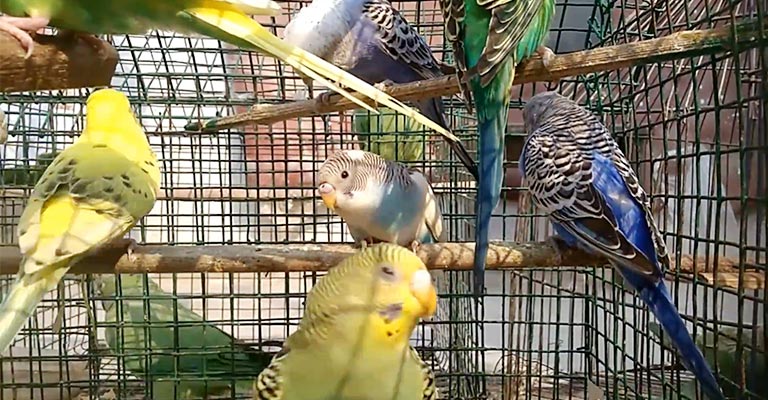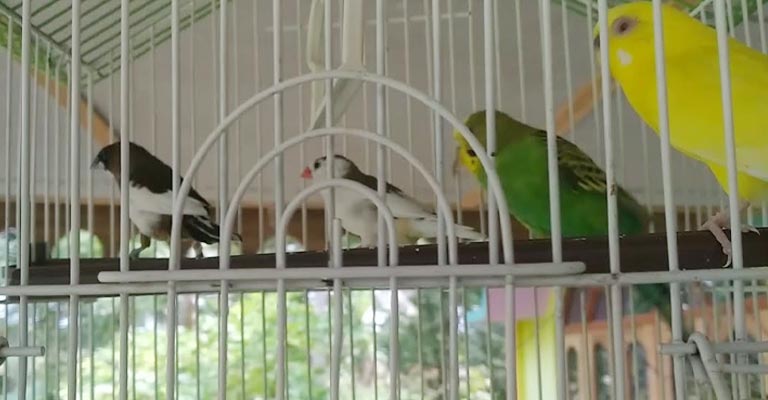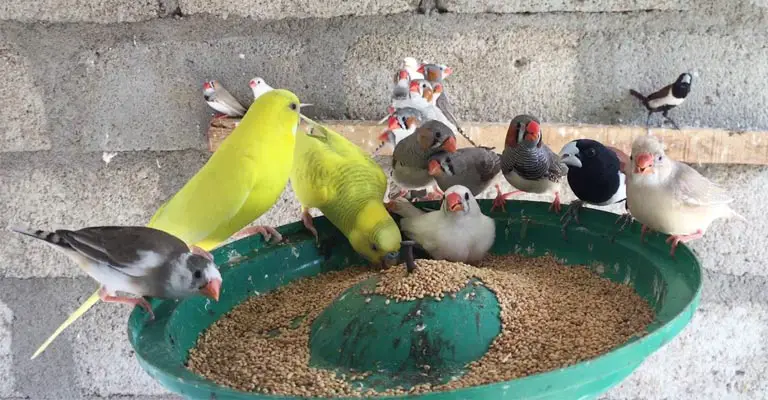Many bird enthusiasts find joy in keeping finches and parakeets as pets due to their vibrant colors, melodious songs, and charming personalities.
However, when considering adding these two avian species to your home, it’s crucial to address the question: Can finches live with parakeets in harmony?
In this informative guide, we will explore the compatibility of these popular bird species and offer insights into creating a peaceful and thriving aviary environment. Both finches and parakeets bring unique qualities to the table.
Finches are known for their dainty appearance and gentle demeanor, while parakeets are admired for their playful and intelligent nature. But are their differences complementary or disruptive when housed together?
By the end of this exploration, you’ll have a clearer understanding of whether these feathered friends can share a happy home, allowing you to make an informed decision when bringing them into your life.

Can Finches Live with Parakeets?
Before delving into the intricacies of keeping finches and parakeets together, it’s essential to familiarize ourselves with the characteristics of each species.
Finches
Finches are small, delicate birds known for their charming appearances and melodious songs. They are sociable creatures, often preferring the company of their own kind, and they are relatively low-maintenance, making them a favorite choice for bird enthusiasts.
Parakeets (Budgerigars)
Parakeets, or budgerigars, are equally beloved for their vibrant plumage and engaging personalities. They are highly intelligent and enjoy interactive play. Parakeets are known to form strong bonds with their human caretakers, which adds to their appeal.
Factors for Successful Cohabitation
To determine whether finches and parakeets can live together harmoniously, several key factors must be considered:
Housing
Adequate space is crucial when housing these birds together. A spacious aviary provides ample room for both species to fly, perch, and exercise without feeling crowded. Separate feeding areas, perches, and nesting boxes can help minimize territorial disputes.
Social Dynamics
Understanding the social behaviors of finches and parakeets is essential. Finches tend to be peaceful and flock-oriented, while parakeets are more interactive and may become territorial. Observing their interactions will give you insights into their compatibility.
Species Mix
The mix of bird species can greatly influence their coexistence. It’s generally recommended to have a higher number of finches than parakeets, as finches are less assertive and may be intimidated by the more assertive parakeets.
Environmental Enrichment
Enrichment is vital for the mental and physical well-being of both finches and parakeets. Provide a variety of toys, swings, and activities to keep them engaged and reduce boredom.
Potential Challenges

While it’s possible for finches and parakeets to coexist, there are potential challenges to consider:
Dietary Differences
Finches and parakeets have distinct dietary requirements. Finches primarily eat seeds, while parakeets enjoy a more varied diet, including fruits and vegetables. Ensuring that each species gets the appropriate nutrition can be a logistical challenge.
Territorial Behavior
Parakeets may exhibit territorial behavior, especially during the breeding season. This can lead to aggression towards finches or even among parakeets themselves. Close monitoring is essential during these times.
Health Considerations
Different species may have varying susceptibility to certain diseases. It’s important to be aware of the specific health concerns associated with both finches and parakeets and take appropriate measures to prevent the spread of illnesses.
Creating a Harmonious Environment
To maximize the chances of peaceful cohabitation between finches and parakeets, follow these tips:
Select Compatible Individuals
Choosing birds with compatible temperaments is crucial. Avoid aggressive or overly dominant individuals, and consider the age and sex of the birds when introducing them.
Regularly monitor their interactions, especially when initially introducing them. Be prepared to intervene if any aggressive or stressful situations arise. Providing separate areas for each species to retreat to can be beneficial.
Enrichment and Play
Keep both finches and parakeets mentally and physically engaged with a variety of toys, perches, and activities. This can help reduce stress and prevent boredom-related issues.
If you’re unsure about the compatibility of your specific birds, seek advice from experienced avian experts or veterinarians. They can offer guidance tailored to your unique situation.
Finches are known for their sociable nature, melodious songs, and gentle demeanor. While they may not be as overtly friendly or interactive with humans as some other pet birds, they can form subtle and trusting bonds with their caregivers.
Are Parakeets a Threat to Other Birds?

When considering adding parakeets to a multi-species aviary or backyard, a common question arises: Are parakeets a threat to other birds? Here, we’ll delve into the interactions and potential impacts of parakeets on other avian species.
Understanding Parakeets
Before addressing their potential threat to other birds, it’s crucial to understand parakeets and their characteristics. Parakeets are known for;
Sociability
Parakeets are social birds, forming strong bonds with their human caretakers and even other birds. This sociable nature is one of their endearing qualities.
Parakeets are highly intelligent and can be trained to perform tricks, mimic human speech, and engage in interactive play.
Playful Behavior
They are active and playful birds, often seen swinging on toys, exploring their environment, and entertaining themselves with various activities.
Parakeets are known for their chirping, chattering, and mimicry of sounds. Their vocalizations add a lively ambiance to any aviary.
Potential Threat to Other Birds
While parakeets have many positive qualities, there are factors that can make them a potential threat to other birds.
Parakeets can exhibit territorial and aggressive behaviors, especially during the breeding season. They may perceive other birds as intruders and may try to defend their space.
Parakeets can be possessive of their food and nesting areas, which can lead to conflicts with other birds that share the same space. The energetic and assertive nature of parakeets can intimidate more passive or delicate bird species.
This intimidation can create stress and affect the overall well-being of other birds in the same aviary.
Assessing Compatibility
The compatibility of parakeets with other bird species depends on several factors:
Species Mix
The mix of bird species in the aviary plays a significant role in determining compatibility. Some birds may be more resilient and adaptable to the presence of parakeets, while others may be more sensitive or vulnerable.
Individual Temperament
The temperament of individual parakeets is crucial. Some parakeets may be more docile and accepting of other birds, while others may be territorial and aggressive. Selecting parakeets with the right temperament is essential.
A spacious aviary provides room for birds to establish their territories and reduces the chances of conflicts. Ensuring that birds have adequate space to fly and move freely can promote peaceful coexistence.
Observation and Intervention
Regular observation of bird interactions is essential, especially when introducing parakeets to an established avian community. Be prepared to intervene if conflicts arise, and provide safe spaces for all birds to retreat to if needed.
Mitigating the Threat
To mitigate the potential threat that parakeets may pose to other birds in an aviary or outdoor environment, consider the following strategies:
Select Compatible Birds
When adding parakeets to an existing bird community, choose species known for their adaptability and tolerance of other birds. Some finches, doves, or canaries may coexist more peacefully with parakeets.
Provide Separate Areas
In larger aviaries, creating distinct areas for parakeets and other bird species can help reduce territorial conflicts. Ensure that each species has access to its feeding, bathing, and nesting areas.
Enrich the aviary with plenty of toys, perches, and activities for all birds. Enrichment can keep birds mentally and physically engaged, reducing stress and potential conflicts.
Observation and Interaction
Spend time interacting with all the birds in your aviary. Providing socialization and training can help build positive relationships between species.
If you’re uncertain about the compatibility of parakeets with other birds, seek advice from experienced avian experts or veterinarians. They can provide guidance tailored to your specific situation.
FAQs
What should I feed my pet finches?
Finches primarily eat a diet of seeds, and a good quality finch seed mix should be the basis of their diet. You can also provide fresh vegetables, greens, and occasional fruits as supplementary food. It’s essential to ensure a varied and balanced diet to meet their nutritional needs.
Can different species of finches be kept together in the same aviary?
In general, it’s best to keep birds of the same species together in an aviary to ensure compatibility. Different species may not always get along, and they may compete for resources.
How can I tell the gender of my finches?
The methods for determining finch gender can vary depending on the species. In many cases, males are more colorful and sing more, while females may be plainer in coloration.
DNA testing or observation of their behavior during the breeding season can also help determine their gender definitively.
Do finches require a specific type of nest for breeding?
Finches are cavity-nesting birds and often breed in enclosed spaces. Providing nesting boxes with a small entrance hole is essential for breeding finches. The type of box and size will depend on the specific finch species you are keeping.
Are finches noisy pets?
Finches are not typically considered noisy pets compared to some other bird species like parrots. While they do sing and chirp, their vocalizations are generally melodic and not overly loud.
However, during the breeding season, males may sing more frequently to attract mates.
Conclusion
The cohabitation of finches and parakeets is indeed possible under certain conditions. Understanding their social dynamics, providing adequate space, and ensuring environmental enrichment are key factors for successful coexistence.
While they have distinct personalities and behaviors, the right approach to housing providing separate feeding areas, and perches, and ensuring sufficient space can mitigate potential conflicts.
Observing their interactions and being vigilant for any signs of stress or aggression is crucial for maintaining a peaceful environment.
Ultimately, the success of keeping finches and parakeets together depends on individual temperaments, the size of the enclosure, and attentive care.
It’s essential to monitor their interactions and be prepared to separate them if needed to ensure the well-being of these captivating birds.
With proper attention and understanding, creating a shared habitat for these charming creatures can be a rewarding and delightful experience for any avian enthusiast.